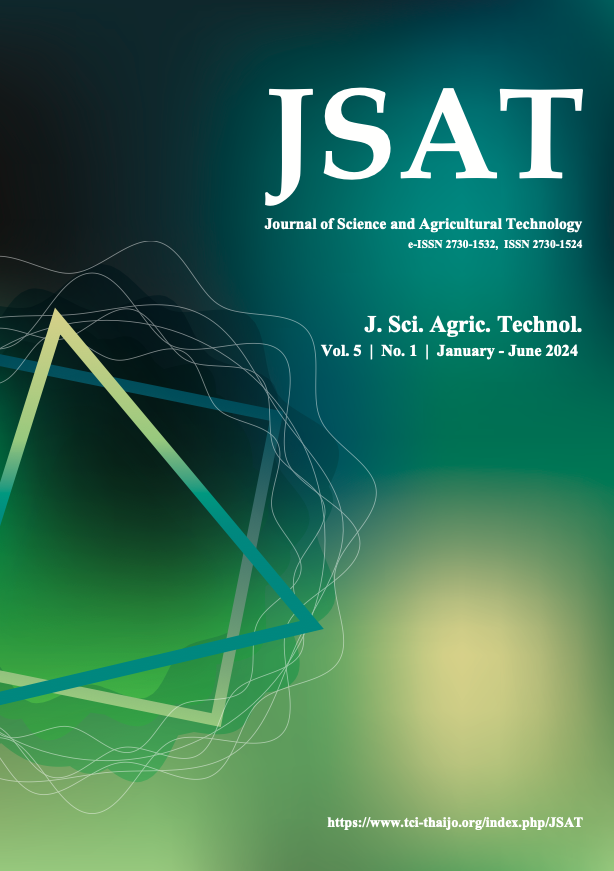Effect of some fermentation factors on the fermented tiger stripe peanut production by Rhizopus microsporus fungus
Main Article Content
Abstract
Article Details

This work is licensed under a Creative Commons Attribution-NonCommercial-NoDerivatives 4.0 International License.
References
AOAC. 2012. Official methods of analysis of AOAC international. 19th ed. Gaitherburg, MD: Association of Official Analytical Chemists.
Arya, S.S., Salve, A.R. and Chauhan, S. 2016. Peanuts as functional food: a review. J. Food Sci Technol. 53(1): 31- 41. https://doi.org/10.1007/s13197-015-2007-9.
Bradford, M.M. 1976. A rapid and sensitive method for the quantitation of microgram quantities of protein utilizing the principle of protein-dye binding. Anal. Biochem. 72(1-2): 248-254. https://doi.org/10.1006/abio.1976.9999.
Baú, T.R. and Ida, E.I. 2015. Soymilk processing with higher isoflavone aglycone content. Food Chem. 183: 161-168. https://doi.org/10.1016/j.foodchem.2015.03.026.
Çiftçi, S. and Suna, G.Ü.L.E.N., 2022. Functional components of peanuts (Arachis Hypogaea L.) and health benefits: A review. Future foods. 5: 100140. https://doi.org/10.1016/j.fufo.2022.100140.
Dolatabadi, S., Walther, G., Gerrits van den Ende, A.H.G. and de Hoog, S. 2013. Diversity and delimitation of Rhizopus microsporus. Fungal Divers. 64: 145–163. https://doi.org/10.1007/s13225-013-0229-6.
Han, BZ., and Nout, R.M. 2000. Effects of temperature, water activity and gas atmosphere on mycelial growth of tempe fungi Rhizopus microsporus var. microsporus and R. microspores var. oligosporus. World J. Microbiol. Biotechnol. 16: 853–858. https://doi.org/10.1023/A:1008974621698.
Lante, A., Barion, G., Zannoni, S., Pastore, M.R., Tinello, F., Dal Cortivo, C., Vamerali, T. and Mosca, G. 2018. An ecofriendly procedure to extract isoflavones from soybean seeds. J. Clean. Prod. 170: 11021110. https://doi.org/ 10.1016/j.jclepro.2017.09.218.
Liu, W.T., Huang, C.L., Liu, R., Yang, T.C., Lee, C.L., Tsao, R. and Yang, W.J. 2023. Changes in isoflavone profile, antioxidant activity, and phenolic contents in Taiwanese and Canadian soybeans during tempeh processing. LWT. 186: 115207. https://doi.org/10.1016/j.lwt.2023.115207.
Lo, D., Romulo, A., Lin, J.-Y., Wang, Y.-T., Wijaya, C.H., and Wu, M.C. 2022. Effect of different fermentation conditions on antioxidant capacity and isoflavones content of soy tempeh. AIMS Agri. Food. 7(3): 567-579. https://doi.org/ 10.3934/agrfood.2022035.
Miller, G.L. 1959. Use of dinitrosalicylic acid reagent for determination of reducing sugar. Anal. Chem. 31(3): 426 - 428. https://doi.org/10.1021/ac60147a030.
Matsuo, M. 2006. Preparation and preferences of peanut-tempeh, peanuts fermented with Rhizopus oligosporus. Food Sci. Technol. Res. 12(4): 270-274. https://doi.org/10.3136/fstr.12.270.
Mukherjee, A., Dutta, D., Banerjee, S., Ringø, E., Breines, E.M., Hareide, E., Chandra, G. and Ghosh, K. 2016. Potential probiotics from Indian major carp, Cirrhinus mrigala. Characterization, pathogen inhibitory activity, partial characterization of bacteriocin and production of exoenzymes. Res. Vet. Sci. 108: 76-84. https://doi.org/10.1016/j.rvsc.2016.08.011.
Nabilah, Y., Prananta, L., Setiyaningsih, I., and Widi, P. 2021. Study of the effect of wrapping type and yeast concentration on the making of peanuts tempeh. In IOP Conference Series: Materials Science and Engineering, 28 September 2020. Medan, Indonesia. p.012091.
Radhakrishnan, R., Pae, S. B., Kang, S. M., Lee, B. K., Lee, I. J., and Baek, I. Y. 2014. An evaluation of amino acid, fatty acid and isoflavone composition in Korean peanut (Arachis hypogaea l.) seeds to improve the nutritional quality of breeding lines.
J. Korean Soc. Appl. Biol. Chem. 57: 301-305. https://doi.org/10.1007/s13765-014-4044-x.
Sadh, P.K., Chawla, P. and Duhan, J.S. 2018. Fermentation approach on phenolic, antioxidants and functional properties of peanut press cake. Food biosci. 22: 113120. https://doi.org/10.1016/j.fbio.2018.01.011.
Sato, V. S., Jorge, J. A., Oliveira, W. P., Souza, C. R. F., and Guimarães, L. H. S. 2014. Phytase production by Rhizopus microsporus var. microsporus biofilm: characterization of enzymatic activity after spray drying in presence of carbohydrates and nonconventional adjuvants. J. Microbiol. Biotechn. 24(2): 177-187. https://doi.org/10.4014/jmb.1308.08087.
Sjamsuridzal, W., Khasanah, M., Febriani, R., Vebliza, Y., Oetari, A., Santoso, I. and Gandjar, I. 2021. The effect of the use of commercial tempeh starter on the diversity of Rhizopus tempeh in Indonesia. Sci. Rep. 11: 23932. https://doi.org/10.1038/s41598-021-03308-6.
Sugahara, S., Ueda, Y., Fukuhara, K., Kamamuta, Y., Matsuda, Y., Murata, T., Kuroda, Y., Kabata, K., Ono, M., Igoshi, K., and Yasuda, S. 2015. Antioxidant effects of herbal tea leaves from yacon (Smallanthus sonchifolius) on multiple free radical and reducing power assays, especially on different superoxide anion radical generation systems. J. Food Sci. 80(11): C2420-C2429. https://doi:10.1111/1750-3841.13092.
Taheri, S.E., Bazargan, M., Vosough, P.R., and Sadeghian, A. 2023. A Comprehensive Insight into Peanut: Chemical Structure of Compositions, Oxidation Process, and Storage Conditions. J. Food Compos. Anal. 125:105700. https://doi.org/10.1016/j.jfca.2023.105770.
Wang, W., and Mejia, E.G.D. 2005. A new frontier in soy bioactive peptides that may prevent related chronic diseases. Compr. Rev. Food Sci. Food Saf. 4(4): 63-80. https://doi.org/ 10.1111/j.1541-4337.2005.tb00075.x.
Wang, Q., Ge, X., Tian, X., Zhang, Y., Zhang, J. and Zhang, P. 2013. Soy isoflavone: The multipurpose phytochemical (Review). Biomed. Rep. 1(5): 697-701. https://doi.org/10.3892/br.2013.129.
Wongputtisin, P., Khanongnuch, C., Pongpiachan, P. and Lumyong, S. 2007. Antioxidant activity improvement of soybean meal by microbial fermentation. Res. J. Microbiol. 2: 577-583.
Wongputtisin, P., Ramaraj, R., Unpaprom, Y., Kawaree, R. and Pongtrakul, N. 2015. Raffinose family oligosaccharides in seed of Glycine max cv. Chiang Mai60 and potential source of prebiotic substances. Int. J. Food Sci. Technol. 50(8): 1750-1756. https://doi.org/10.1111/ijfs.12842.
Wongputtisin, P., Khanongnuch, C., Khongbantad, W., Niamsup, P. and Lumyong, S. 2012. Screening and selection of Bacillus spp. for fermented corticate soybean meal production. J. Appl. Microbiol. 113(4): 798-806. https://doi.org/10.1111/j.1365-2672.2012.05395.x.


